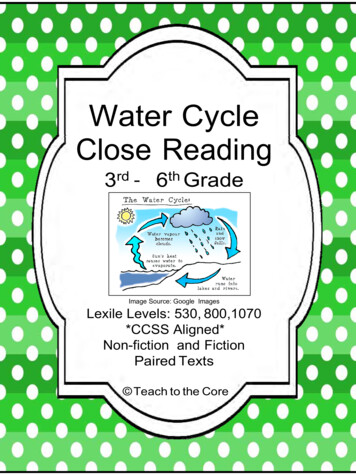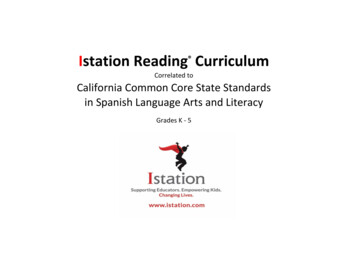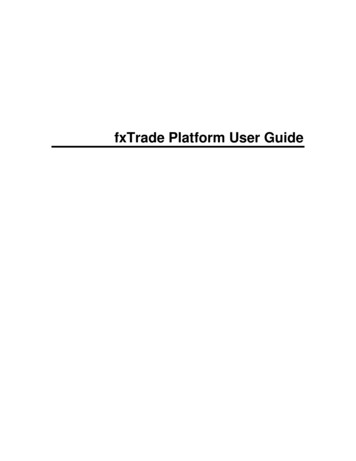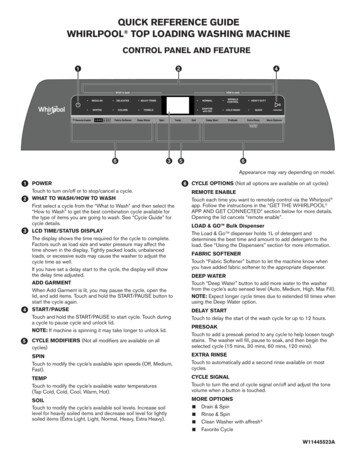
Transcription
Water CycleClose Reading3rd - 6th GradeImage Source: Google ImagesLexile Levels: 530, 800,1070*CCSS Aligned*Non-fiction and FictionPaired Texts Teach to the Core
HOW TO USE:During close reading, the teacher and studentswill read the text together each day. At the beginningof each reading, the teacher calls attention to thestandards that will be discussed that day (objectives).When the text is reread each day, students gain anincreased understanding. On days 3/4/5, I like tohave the students read the text in partners. As yourstudents become more familiar with the standards,they will become more independent thinkers. I havepaired non-fiction text with literature: “The RainStomper” by Addie Boswell (I purchased my copy onmy Kindle app through Amazon). When comparingtwo texts for reading informational standards, I use“The Water Cycle” by Craig Hammersmith, alsopurchased on Amazon (ISBN-10: 1429671424).Anytext online will also work.To increase student understanding, I havecreated graphic organizers to meet the standards(reading informational and reading literature). I haveindicated at the bottom of each graphic organizerwhat grade level and what standards the organizerwill incorporate. Depending on the lexile levels thatyou use for your students, you will choose yourgraphic organizer. I have organized it by grade levelas best as I can. Remember, you need to provideyour students with text that is slightly above theirreading level during shared reading because they haveyour support throughout the process. I have alsoincluded a graphic organizer at the end of this file tohelp your students organize their thoughts forinformational writing. Be sure to rate this product inour store! Thank you for your purchase!! Teach to the Core
PREVIEWTexts are in 3 lexile levels: 530, 800, and 1070Graphic Organizers are provided according tostandard and grade level (just a few of the 33 provided):
The Water CycleLexile Level: 530The water cycle is really important for life on Earth. It isthe journey that water takes from land to sky and back again.When it’s warm outside, water will go up into the air. This iscalled evaporation. The water that evaporates comes from theground. It also comes from the ocean, rivers, and lakes.AWhen the water evaporates into the air it is called watervapor. When the water vapor cools down it will come togetheras tiny water droplets. The droplets will form into a cloud.This is called condensation.BWhen the cloud becomes heavy with a lot of water droplets,it will start to rain. Gravity pulls the water to the ground. If it’scold outside, it will start to snow or hail. This is calledprecipitation.CIf water falls as snow it will collect on the mountains. It willmelt and run down to the rivers and lakes. The water will alsocollect on land. This is known as surface runoff. The watercycle will repeat. The water will evaporate again when there iswarm air.DWater will evaporate whenit’s warm. It will precipitatewhen it condenses and coolsdown. Teach to the CoreIllustration Courtesy: Google Images
The Water CycleLexile Level: 800The water cycle is really important for life on Earth. It isthe journey that water takes from land to the sky and back toland again. When the temperature rises, water will go up intothe air. This is called evaporation. The water that evaporatescomes from the ground, ocean, rivers, and lakes.BWhen water evaporates into the air it is called watervapor, which is considered to be a gas. When the water vaporcools down it will come together as tiny water droplets andform into a cloud. This is called condensation.CWhen the cloud becomes heavy with many water droplets,gravity will pull the water droplets down and it will start to rain.If it’s cold outside, it will start to snow or hail. This is calledprecipitation.DIf water falls as snow it will collect on the mountains. Itwill melt and run down to the rivers and lakes. This is known assurface runoff. The water will also soak into the ground, whichis known as groundwater. The water cycle will repeat and thewater will evaporate again when the temperature rises. Thewater that evaporates using the water cycle is only 1% of thetotal water on our planet.AWater will evaporate whenit’s warm. It will precipitatewhen it condenses and coolsdown.Illustration Courtesy: Google Images Teach to the Core
BEFORE ReadingMake a prediction of what the text will be about.What do you already know about the topic?What questions do you have?DURING ReadingWhat new facts have you discovered?What are you wondering about?What is the most important idea so far?AFTER ReadingWhat was the main idea of this text?What connections did you make while reading?What are you still wondering about?Activating Prior Knowledge/Before, During, and After Reading -3rd-6th Grade Teach to the Core
RI.2.1, RI.3.1Asking and Answering Questions1. What question could you ask about the text?2.Write the answer to your question. Use a complete sentence.Highlight the text BLUE that shows where you found the answerto your question.3.What is another question you could ask about the text?4.Write the answer to your question. Use a complete sentence.Highlight the text RED that shows where you found the answerto your question.VisualizingDraw a picture of what you are visualizingfrom one of the questions you asked.Asking and Answering Questions/Visualizing - 2nd-3rd Grade Teach to the Core
RI.2.2, RI.3.2Main Topic and Key DetailsThe main topic of the text is.Underline a key detail from each paragraph that supportsthe main topic of the text. Write those details here:Paragraph A:Paragraph B:Paragraph C:Paragraph D:Main Topic and Key Details/K- 2nd Grade Teach to the Core
RI.2 (3rd-6th Grades)Main Idea, Key Words, and SummaryThe main idea of the text is.For each paragraph, list the 3 most important words:ABCDUsing the Main Idea and Key Words, write a SUMMARY.(use complete sentences, quote the text accurately)Main Topic, Key Words, Summary/3rd-6th Grade Teach to the Core
RI.2.3, RI.3.3, RI.3.8Connecting Ideas in the TextDescribe the relationship of the concepts in the onnecting Ideas in the Text/2nd-3rd Grade Teach to the Core
RI.4 (2nd-6th Grades)VocabularyFor each word, identify the base word, prefix/suffix, write themeaning, write a sentence, and draw a picture to help you remember.WordBaseWord,Prefix/SuffixWrite themeaningWrite asentenceDraw aPictureevaporationwater aterVocabulary/2nd-6th Grade Teach to the Core
RI.3.5, RI.4.5Text Features/Text Structure1. Locate a word that is bold-faced. Highlight it PURPLE.What is that word?What does the author say that this word means?2.What is the text feature at the end of the text?What does this text feature teach you about this topic?Explain why the author would include this text feature.3. What is the overall structure of the text (chronology,comparison, cause/effect, problem/solution)? How do you know?Locating Text Features/3rd-4th Grade Teach to the Core
RI.6 (2nd-6th)Author’s Purpose/Point of ViewWhat is the author’s main purpose for writing this text?How do you know? What does the author want to explain?What is the author’s point of view on this topic?How is the author’s point of view conveyed in the text?What is your point of view on this topic?How is your point of view different and/or similar to theauthor’s point of view?Author’s Purpose/Point of View/2nd-6th Grade Teach to the Core
RI.6, RI.7 (2nd-4th Grade)Text vs. IllustrationsUsing the text, describe the key details.Using the illustration in the text, describe the key details.Explain how the illustration helps clarify the text (usewords- where, when, why, and how when explaining).Text vs. Illustrations/2nd-4th Grade Teach to the Core
RI.4.8, RI.5.8, RI.6.8Text EvidenceExplain the evidence the author makes about each of theseparticular points in the text:Water CycleEvaporationCondensationPrecipitationSurface RunoffGroundwaterText Evidence- Describing Points an author makes/4th-6th Grade Teach to the Core
RI.4.9, RI.5.9, RI.6.9Comparing TextsRead another text on the water cycle (Text 2). Writethe key details of each. Write down what is similar anddifferent between the two texts. Add in a third text onanother sheet of paper if needed. Integrate theinformation and write an informative paper about thewater cycle.Key Details of Text 1Key Details of Text 2What is similar between the two texts?What is different between the two texts?Comparing Texts/K-3rd Grade Teach to the Core
The Water CycleLexile Level: 1070The water cycle is a complex process that gives us waterto drink, lakes for our fish to swim, and water for our crops togrow. About three-fourths of the Earth is covered in water.97% of the water on Earth is salt water and about 3% of theEarth’s water is fresh. 2% of the Earth’s water is frozen inglaciers and ice caps, which leaves 1% of our Earth’s water forhumans and animals to use in lakes, rivers, and streams.BThe warmth from the sun will cause the water toevaporate into the air. As water evaporates, it will leaveimpurities behind. Therefore, the water that evaporates intothe air is cleaner in the atmosphere than it is on the Earth. Thewater that evaporates comes from the ground, plants, oceans,rivers, and lakes.CWhen water evaporates into the air, it changes from aliquid to a gas called water vapor. When the water vapor coolsdown the tiny water droplets come together to form into acloud. Dust particles will also join the water droplets. This iscalled condensation.DWhen the cloud becomes heavy with a lot of waterdroplets, gravity will pull the water droplets down and it willstart to rain. This is called precipitation. If there are freezingtemperatures, it will start to snow or hail. If water falls as snowit will collect on the mountains. It will melt and run down to therivers and lakes. This is known as surface runoff.EThe water will also collect on land, which is a processcalled infiltration. The water that soaks into the ground isknown as groundwater. An important part of the water cycle istranspiration. During this process, water is collected into theroots of plants and will travel through the plant to the leaves.The water will then evaporate off of the leaves when theconditions are right. The water cycle will repeat and the waterwill evaporate again when the temperature rises.A
BEFORE ReadingMake a prediction of what the text will be about.What do you already know about the topic?What questions do you have?DURING ReadingWhat new facts have you discovered?What are you wondering about?What is the most important idea so far?AFTER ReadingWhat was the main idea of this text?What connections did you make while reading?What are you still wondering about?Activating Prior Knowledge/Before, During, and After Reading - 3rd-6th Grade Teach to the Core
RI.4.1, RI.5.1, RI.6.1Making InferencesBecause of this key detail inthe text (state explicitly):Because of this key detail inthe text (state explicitly):.and I know that.and I know thatI can infer that.I can infer that.Making Inferences/4th - 6th Grade Teach to the Core
RI.3.2, RI.4.2, RI.5.2, RI.6.2Main Topic and Key DetailsThe main topic of the text is.Underline a key detail from each paragraph that supportsthe main topic of the text. Write those details here:Paragraph A:Paragraph B:Paragraph C:Paragraph D:Paragraph E:Main Topic and Key Details/3rd-6th Grade Teach to the Core
RI.2 (3rd-6th Grades)Main Idea, Key Words, and SummaryThe main idea of the text is.For each paragraph, list the 3 most important words:ABCDEUsing the Main Idea and Key Words, write a SUMMARY.(use complete sentences, quote the text accurately)Main Topic, Key Words, Summary/3rd-6th Grade Teach to the Core
RI.4.3, RI.5.3, RI.6.3Connecting Ideas in the TextExplain the relationship of concepts in the text.Quote the text accurately when explaining why.WHAT HAPPENED?WHY?WHAT HAPPENED?WHY?WHAT HAPPENED?WHY?WHAT HAPPENED?WHY?Connecting Ideas in the Text/4th-6th Grade Teach to the Core
RI.4 (2nd-6th Grades)VocabularyFor each word, identify the base word, prefix/suffix, write themeaning, write a sentence, and draw a picture to help you remember.WordBaseWord,Prefix/SuffixWrite themeaningWrite asentenceDraw rationgroundwatertranspirationVocabulary/2nd-6th Grade Teach to the Core
RI.6.5Analyzing Overall Text Structure1. What is the overall structure of the text (chronology,comparison, cause/effect, problem/solution)?How do you know?2. Describe the key details of Paragraph A.3. How does this paragraph fit into the overall structure ofthe text and contribute to the development of the topic?Analyzing Overall Text Structure/5th-6th Grade Teach to the Core
RI.6 (2nd-6th)Author’s Purpose/Point of ViewWhat is the author’s main purpose for writing this text?How do you know? What does the author want to explain?What is the author’s point of view on this topic?How is the author’s point of view conveyed in the text?What is your point of view on this topic?How is your point of view different and/or similar to theauthor’s point of view?Author’s Purpose/Point of View/2nd-6th Grade Teach to the Core
RI.5.7, RI.6.7Comparing Texts to Increase UnderstandingWrite down questions you still have about the topic.Read another text or research online to answer your questionsabout the topic (Text 2). Compare the information to Text 1 andwrite the key details of each.Key Details of Text 1Key Details of Text 2*On another sheet of paper, describe how your questions wereanswered and how your understanding has increased on this topic.Comparing Texts to Increase Understanding/5th-6th Grade Teach to the Core
RI.4.8, RI.5.8, RI.6.8Text EvidenceExplain the evidence the author makes about each of theseparticular points in the text:Water CycleEvaporationCondensation and PrecipitationSurface Runoff and GroundwaterInfiltrationTranspirationText Evidence- Describing Points an author makes/4th-6th Grade Teach to the Core
RI.4.9, RI.5.9, RI.6.9Comparing TextsRead another text on the water cycle (Text 2). Writethe key details of each. Write down what is similar anddifferent between the two texts. Add in a third text onanother sheet of paper if needed. Integrate theinformation and write an informative paper about thewater cycle.Key Details of Text 1Key Details of Text 2What is similar between the two texts?What is different between the two texts?Comparing Texts/K-3rd Grade Teach to the Core
RL.3.1Asking and Answering Questionsin LiteratureFrom the text, use the 5 W’s to ask questions:WhoWhatWhereWhenWhyHighlight one to three of the questions above and write down the answer to thequestions. Use a complete sentence.1)2)3)Ask and Answer Questions in Lit/3rd Grade Teach to the Core
RL.3.2Retelling the StoryI Can Retell Stories andDetermine the Central Messageby Referring to the Key DetailsDetail #1Detail #2Detail #3Detail #4Based on the key details, what is the central message/theme ofthe story?Retelling the Story/Central Message in Lit/3rd Grade Teach to the Core
RL.3.3, RL.4.3Character Traits/MotivationsDescribe Jazmin’s character traits in the story.Jazmin’s MotivationsJazmin’s FeelingsDescribe how Jazmin’s actions, thoughts, and wordscontribute to the sequence of events in the story.Character Traits and Motivations in Lit/3rd-4th Grade Teach to the Core
RL.4.1, RL.5.1, RL.6.1Making Inferences in LiteratureReferring to the details in the text on pages 3-6, makeinferences about how Jazmin feels about the rain.The Text Says.From the illustrations, I see-I Say.I can make inferences about how Jazmin feels.Making Inferences in Lit/3rd-6th Grade Teach to the Core
RL.3Central Message/ThemeDetermine the central message/theme of the storyfrom the key details in the text. Summarize the text.What are the key details in the text?****From the key details, determine the centralmessage/theme of the story. How do you know?Summarize the text.Retelling the Story/Central Message in Lit/3rd-6th Grade Teach to the Core
RL.3Compare and Contrast Actions/EventsDescribe Jazmin’s actions and how it affects the otherchildren in the story. Describe how the plot unfolds as thecharacters respond to the events in the story.Jazmin’s Actions:Children’s Actions:Jazmin’s Actions:Children’s Actions:Jazmin’s Actions:Children’s Actions:Describe how the plot unfolds and moves to a resolution based onthe characters’ actions:Character Traits and Motivations in Lit/5th-6th Grade Teach to the Core
RL.3.4, RL.4.4The Meaning of Words/Phrases in the StoryWrite down phrases in the story (see first example) anddescribe the literal and non-literal meaning in the story.Phrases used in theStoryDescribe the literalmeaningDescribe the nonliteral meaning“Rain poured down inbuckets.”Literal and Non-Literal Meaning in Stories/3rd-4th Grade Teach to the Core
RL.5.4, RL.6.4Metaphors/SimilesWrite down the metaphors in the story. Turn them intosimiles. Rewrite the story by using the similes andcreating a different version of the story.Metaphors used in the StoryChange the metaphor into a simile.How does it change the meaning ortone of the story?“Rain poured down in buckets.”Metaphors and Similes in Stories/5th-6th Grade Teach to the Core
RL.7Meaning of Words/PhrasesExplain how the following descriptions of the charactersgive meaning to their actions. Explain how it contributesto the events in the story.Jazmin: “Rain Stomper”Children: “Puddle Splashers”How does the descriptions of the characterscontribute to the events in the story?Making Inferences in Lit/3rd-6th Grade Teach to the Core
Referring to the Water Cycle text, write a paragraph onhow the story of The Rain Stomper helps youunderstand the Water Cycle.Making Connections between informative and literature texts Teach to the Core
Informative Writing Graphic OrganizerTopic Sentence (begin with a question about your topic or aninteresting fact about your topic - then introduce your topic):Fact #1 (start with a linking word - tell more about your fact - elaborate)Fact #2(start with a linking word - tell more about your fact - elaborate)Fact #3(start with a linking word - tell more about your fact - elaborate)Conclusion (start with a concluding phrase, restate your topic sentence, restateyour facts)Informative Writing Graphic Organizer Teach to the Core
CREDITSFrames:Background Paper:Pair non6fic8on with literature:Font:Hello LiteracyOther Resources:Google Images“The Rain Stomper” by Addie Boswell – purchased onAmazon.com*Copyright 2010. Na8onal Governors Associa8on Center forBest Prac8ces and Council of Chief State School Officers. Allrights reserved.
(reading informational and reading literature). I have indicated at the bottom of each graphic organizer what grade level and what standards the organizer will incorporate. Depending on the lexile levels that you use for your students, you will choose your graphic organizer. I have organ










